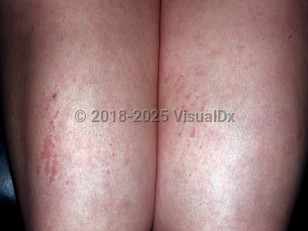AOSD is characterized by spiking fevers that typically peak in the late afternoon or early evening, a pink or salmon-colored evanescent rash, polyarthralgia, hepatosplenomegaly, lymphadenopathy, and sore throat. Fever, rash, and arthralgias occur in most patients. Arthralgias and arthritis typically affect the knees, ankles, and wrists.
There are 3 different patterns in the clinical evolution of AOSD.
- The monocyclic pattern is self-limited and characterized by one flare of variable duration followed by complete remission.
- The polycyclic pattern is marked by 2 or more episodes with intervening symptom-free periods.
- The chronic articular pattern is characterized by severe joint manifestations that lead to joint-space narrowing and destruction.
Renal diseases, most commonly AA amyloidosis, have been associated with AOSD and may increase morbidity and mortality. Other causes of renal disease include collapsing glomerulopathy, thrombotic microangiopathy, IgA nephropathy, and minimal change disease. Late carpal ankylosis occurs in approximately 25% of patients and represents a distinct clinical feature differentiating AOSD from rheumatoid arthritis.



